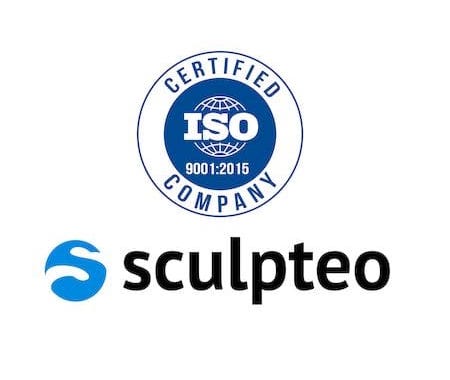![Sculpteo’s certification means something to the entire 3D print service industry [Source: Fabbaloo]](https://fabbaloo.com/wp-content/uploads/2020/05/image-asset_img_5eb0a05f49147.jpg)
Sculpteo announced they’ve achieved ISO 9001-2015 certification.
If you’re not familiar with ISO 9001, this is what it’s about, according to Wikipedia:
“The ISO 9000 family of quality management systems standards is designed to help organizations ensure that they meet the needs of customers and other stakeholders while meeting statutory and regulatory requirements related to a product or service. ISO 9000 deals with the fundamentals of quality management systems, including the seven quality management principles upon which the family of standards is based.”
And those seven standards are:
Principle 1 – Customer focus
Organizations depend on their customers and therefore should understand current and future customer needs, should meet customer requirements and strive to exceed customer expectations.
Principle 2 – Leadership
Leaders establish unity of purpose and direction of the organization. They should create and maintain the internal environment in which people can become fully involved in achieving the organization’s objectives.
Principle 3 – Engagement of people
People at all levels are the essence of an organization and their full involvement enables their abilities to be used for the organization’s benefit.
Principle 4 – Process approach
A desired result is achieved more efficiently when activities and related resources are managed as a process.
Principle 5 – Improvement
Improvement of the organization’s overall performance should be a permanent objective of the organization.
Principle 6 – Evidence-based decision making
Effective decisions are based on the analysis of data and information.
Principle 7 – Relationship management
An organization and its external providers (suppliers, contractors, service providers) are interdependent and a mutually beneficial relationship enhances the ability of both to create value.
In other words, Sculpteo was able to successfully demonstrate their company now has routinely practiced processes that address each and every one of these principles. After you read through these, would you not be more attracted to using a service that was certifiably using such practices?
Sculpteo’s chief, Clément Moreau, explains:
“Only yesterday was 3D printing considered an imperfect technology; it has now become a tool opened to, not only some pioneers, but an asset of the largest industrial companies. Obtaining the ISO 9001-2015 standard is the result of a process that mobilized all of Sculpteo’s skills. It certifies the level of quality and precision of its different 3D printing services, which suit the most demanding manufacturing process of the upper industries.”
This is a fundamental point and it shows how far 3D printing has come.
In past years one might consider using a 3D print service because you “did not have a 3D printer of your own”. That is changing due to the dramatically decreasing cost of acquiring and operating relatively powerful 3D printers, some now offering the ability to 3D print in a variety of engineering materials. The world of 3D printing is overflowing with professional devices vastly more powerful than yesterday’s hokey desktop machines that may or may not print successfully on any given day. And the new machines are not expensive, either.
So why buy 3D prints through a service at all?
Because they provide the consistency and reliability you don’t have.
You’re not buying a “machine” through a 3D print service anymore. No, you’re buying a consistent product, one that you can rely on each and every time, even if you require thousands of units.
Even if you were able to buy one of the expensive 3D printers used at services like Sculpteo, could you operate it in a manner that would provide the exact same result each and every time? It’s the process you’re buying, not the machine time.
This is a cautionary flag to other 3D print services: obtain certifications or you may fall behind your competitors.
Via Sculpteo











MakerOS has a brilliant hidden feature in their online service: a sophisticated 3D print pricing calculator that allows operators to determine exactly how to price prints.